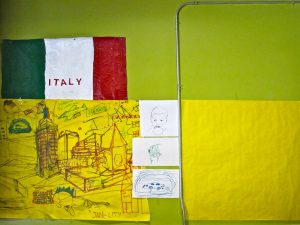
Sketches for “Jam City”, a 2013 collaborative design project re-imagining Newburgh, at the Boys & Girls Club of Newburgh
The Hudson Valley is arguably the birthplace of arts in America. Last week, in a Poughkeepsie Journal op-ed, writer Sandi Sonnenfeld convincingly argued that the Trump administration’s proposal to eliminate the National Endowment of the Arts (NEA), along with the National Endowment for the Humanities (NEH) and the Corporation for Public Broadcasting (CPB) would have massive negative consequences for the reemerging arts communities here, where it all began.
Sonnenfeld, who lives in Poughkeepsie, cited a 2014 Benjamin Center study that examined the economic impact of arts and culture in the Mid-Hudson Valley, defined as Dutchess, Orange, Putnam, Sullivan, Rockland, Ulster and Westchester Counties. She wrote:
“The elimination of federal funding for the arts and humanities is especially problematic for those of us who live in the Hudson Valley. According to a study conducted by SUNY New Paltz’s Center for Research, Regional Education and Outreach [now the Benjamin Center], Mid-Hudson arts and culture organizations attract 2.6 million day visitors and 1 million overnight visitors to the region for cultural events, injecting $498 million directly into our local economy every year. The local arts scene also directly and indirectly employs nearly 5,000 residents. In Dutchess, Ulster and Orange counties, Arts Mid-Hudson helps provide grants to 393 organizations and individual artists. Guess where the majority of Arts Mid-Hudson’s funding comes from? From the New York [State] Council for the Arts (NYSCA), which is funded by New York state and yes, the NEA.”
A comparison is revealing. According to Sonnenfeld, the German government spends on average $20 per citizen on the arts, while the US government spends 41 cents per citizen. That’s a 40:1 ratio. “Yet that small pittance matters immensely,” she writes, “providing much-needed money that supports community arts projects, new works and making the arts accessible to people in all 50 states and discount tickets for students and the less wealthy.”
Still, Sonnenfeld’s assessment of the impact of Trump’s proposed budget cuts is likely an underestimation. Consider: Organizations like the Boys & Girls Club of Newburgh offer year-round arts programming that connect students to spaces long committed to art and community, like Ann Street Gallery, and to artists like Vincent Cianni, who have been creating engaging work in and about Newburgh for the last decade and more. The Newburgh Free Library’s summer arts program for pre-K students to adults includes lunches and community engagement projects. It relies on New York State Council on the Arts (NYSCA) decentralization grants from Arts Mid-Hudson. Cutting funding for these programs undermines arts and reading programs that mainly help children in under-resourced cities.
The Mid-Hudson Valley’s renewal as an arts epicenter is fed by a steady stream of artists and art workers seeking refuge from gentrified Brooklyn, Queens, and the Lower East Side of Manhattan. Word of mouth, buzz, New York Times real estate reporting, and the growing population of college graduates trained in the arts in the area has resulted in robust migration into the historic cities of the Mid-Hudson Valley: Kingston, Beacon, Newburgh, and Hudson among them. These are now must-visit cities for their arts-centered downtowns and for their diverse cultural programming and small, service oriented businesses.
Local communities are collaborating to foster these new cultural and commercial developments. Kingston offers city-wide programming on the first Saturday of each month, Beacon the second, and Newburgh ends out the month with Newburgh Last Saturdays. On those weekends, businesses and restaurants in those cities report higher pedestrian and automobile traffic as well as higher revenues. On Newburgh Last Saturdays artists and musicians often gather to hear original classical compositions at the Atlas Studios as part of the “Queen of the Hudson” series of concerts. Many artists and makers in attendance defray the costs of their exhibitions, their programs, and the increasing costs of living in the Hudson Valley through NYSCA’s decentralization grants and through the New York Foundation for the Arts (NYFA) funding. Both grants distribute funds that trickle down from the NEA. Larger concert halls, like the Bardavon in Poughkeepsie rely on larger grants from NYSCA to continue their programming.
Consider as well the number of businesses in the Mid-Hudson Valley that rely on the patronage of artists, makers, and Hudson Valley art tourists. Newburgh Art Supply, a well stocked store for quality art supplies, built into the first floor of the home artists Michael Gabor and Gerardo Castro share, might well shutter if not for the modest public funding of the arts that enters the local economy. Businesses like theirs and like Newburgh Mercantile, a framing and specialty goods store, and American Icon, a shirt-printing operation, rely exclusively on the networks that make up the arts community in the Hudson Valley. These businesses are the early fruits of our public investment in community renewal that is now beginning to produce robust art practices in our communities. Cutting off federal funding will save little but is likely to do irreparable harm to our still fragile developing arts communities and industries, and there’s no telling when we’ll find our footing again.

March 30, 2017 at 1:49 pm
This is very real for all arts organizations in the Hudson Valley, and now the White House is proposing 15M of cuts to THIS year’s NEA budget (FY2017). As the co-leaders of the Hudson Valley Shakespeare Festival, I’m grateful for your advocacy and for this thoughtful piece. We’ve got your back and are grateful that you have ours. See our corresponding piece here: https://hvsfblog.wordpress.com
Thanks!
Davis McCallum, Artistic Director
Kate Liberman, Managing Director